BSBHRM501: Detailed Assessment of Human Resource Service Delivery
VerifiedAdded on 2021/02/21
|74
|13182
|20
Homework Assignment
AI Summary
This document outlines the assessment criteria for BSBHRM501: Manage Human Resource Services, covering elements for competency, foundation skills, and assessment requirements. It details strategies for delivering human resource services, managing their delivery, evaluating service effectiveness, and integrating business ethics. The assessment includes performance evidence, knowledge evidence, and various assessment tools such as learner workbook activities, observations, major activities, skills and knowledge activities, third-party checklists, case studies, and learner guides. The document also provides an observation checklist to evaluate learners' abilities to analyze business strategies, consult with managers, develop service delivery options, and manage the delivery of human resource services. The document emphasizes the importance of demonstrating skills in reading, writing, oral communication, and numeracy, as well as navigating the world of work and interacting with others. Reassessment attempts are allowed if competency is not achieved initially. The document also references companion volumes available from the IBSA website and highlights the need for assessors to meet NVR/AQTF requirements.

Name: ________________________________
Paraphrase This Document
Need a fresh take? Get an instant paraphrase of this document with our AI Paraphraser
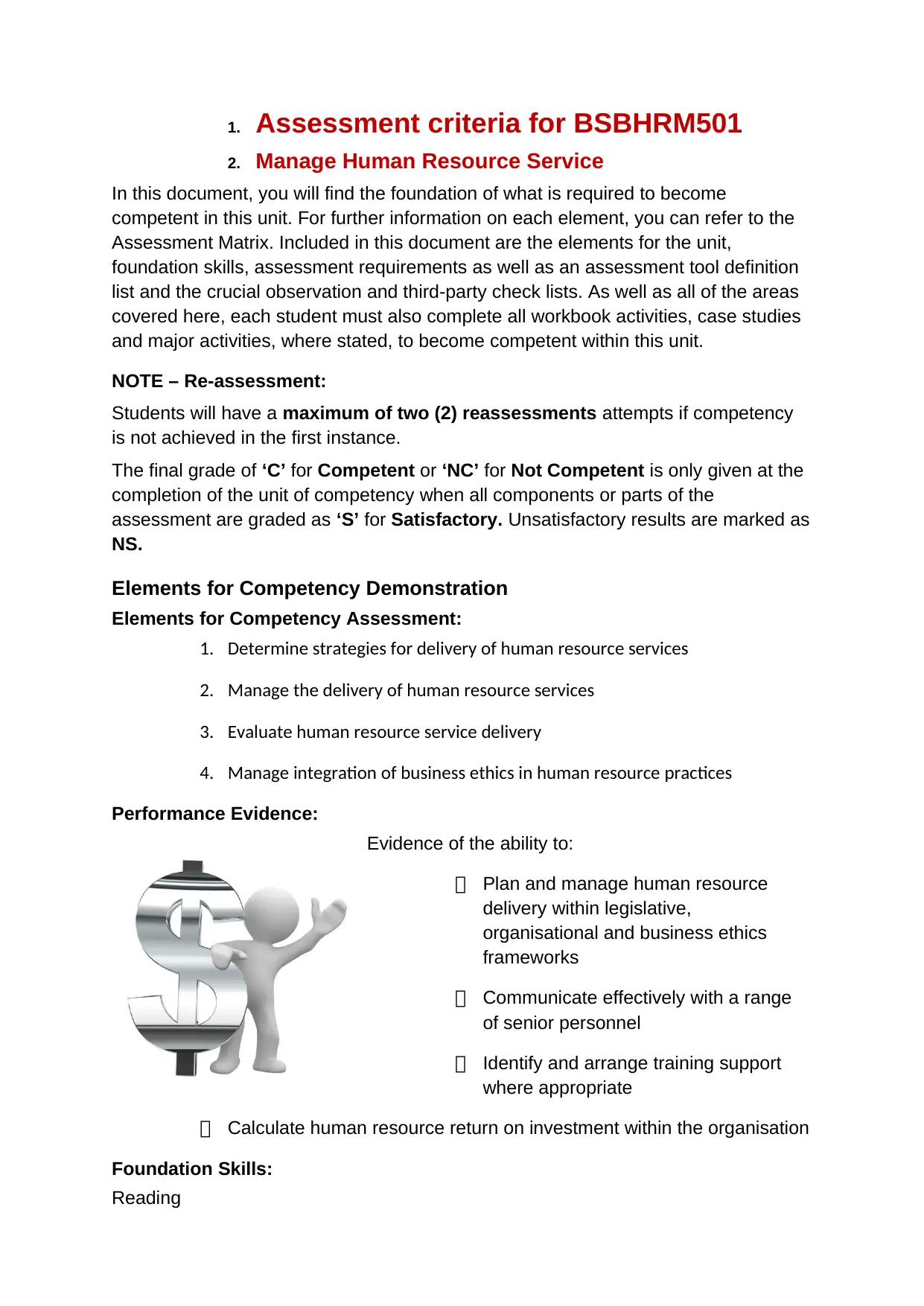
1. Assessment criteria for BSBHRM501
2. Manage Human Resource Service
In this document, you will find the foundation of what is required to become
competent in this unit. For further information on each element, you can refer to the
Assessment Matrix. Included in this document are the elements for the unit,
foundation skills, assessment requirements as well as an assessment tool definition
list and the crucial observation and third-party check lists. As well as all of the areas
covered here, each student must also complete all workbook activities, case studies
and major activities, where stated, to become competent within this unit.
NOTE – Re-assessment:
Students will have a maximum of two (2) reassessments attempts if competency
is not achieved in the first instance.
The final grade of ‘C’ for Competent or ‘NC’ for Not Competent is only given at the
completion of the unit of competency when all components or parts of the
assessment are graded as ‘S’ for Satisfactory. Unsatisfactory results are marked as
NS.
Elements for Competency Demonstration
Elements for Competency Assessment:
1. Determine strategies for delivery of human resource services
2. Manage the delivery of human resource services
3. Evaluate human resource service delivery
4. Manage integration of business ethics in human resource practices
Performance Evidence:
Evidence of the ability to:
Plan and manage human resource
delivery within legislative,
organisational and business ethics
frameworks
Communicate effectively with a range
of senior personnel
Identify and arrange training support
where appropriate
Calculate human resource return on investment within the organisation
Foundation Skills:
Reading
2. Manage Human Resource Service
In this document, you will find the foundation of what is required to become
competent in this unit. For further information on each element, you can refer to the
Assessment Matrix. Included in this document are the elements for the unit,
foundation skills, assessment requirements as well as an assessment tool definition
list and the crucial observation and third-party check lists. As well as all of the areas
covered here, each student must also complete all workbook activities, case studies
and major activities, where stated, to become competent within this unit.
NOTE – Re-assessment:
Students will have a maximum of two (2) reassessments attempts if competency
is not achieved in the first instance.
The final grade of ‘C’ for Competent or ‘NC’ for Not Competent is only given at the
completion of the unit of competency when all components or parts of the
assessment are graded as ‘S’ for Satisfactory. Unsatisfactory results are marked as
NS.
Elements for Competency Demonstration
Elements for Competency Assessment:
1. Determine strategies for delivery of human resource services
2. Manage the delivery of human resource services
3. Evaluate human resource service delivery
4. Manage integration of business ethics in human resource practices
Performance Evidence:
Evidence of the ability to:
Plan and manage human resource
delivery within legislative,
organisational and business ethics
frameworks
Communicate effectively with a range
of senior personnel
Identify and arrange training support
where appropriate
Calculate human resource return on investment within the organisation
Foundation Skills:
Reading
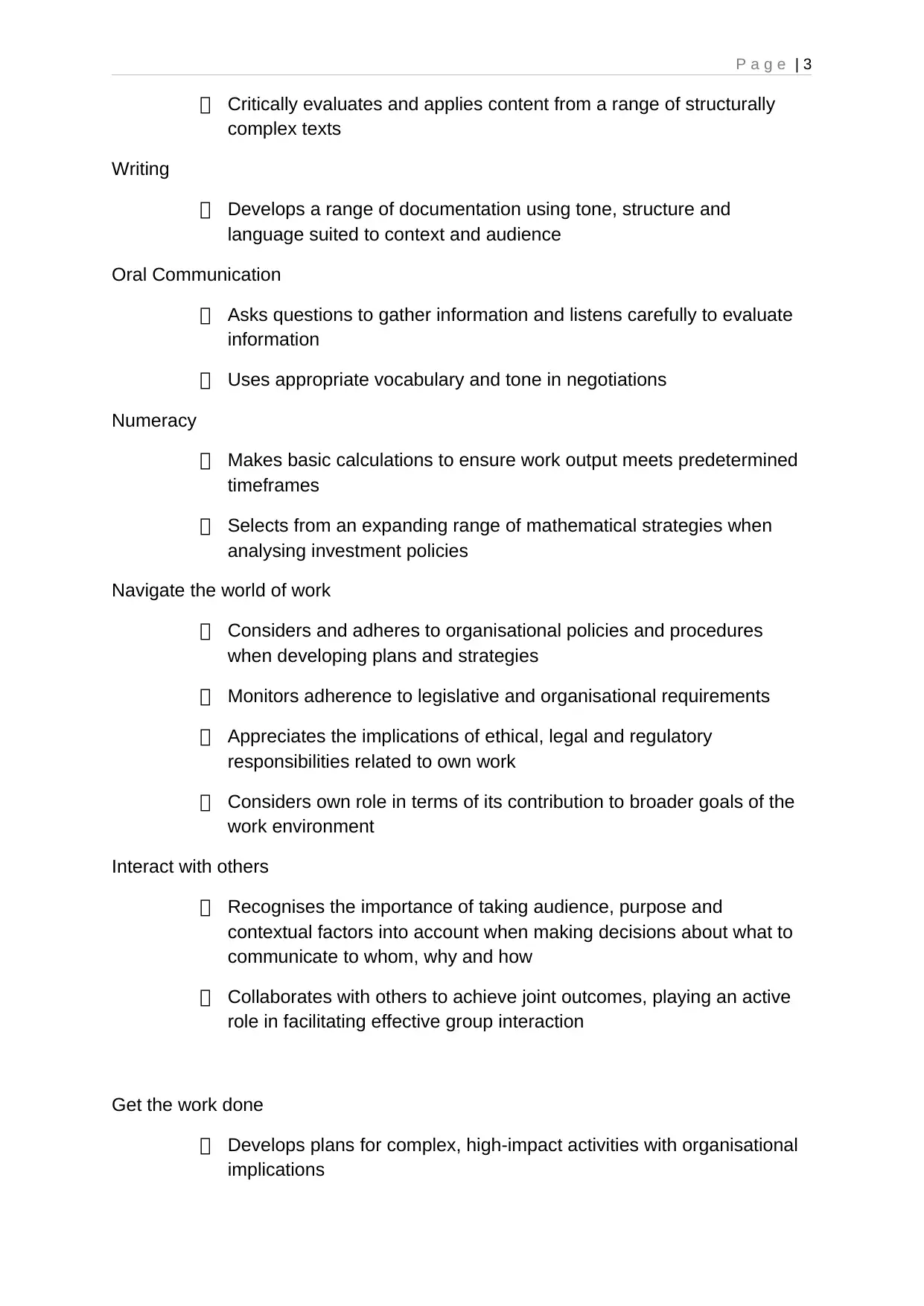
P a g e | 3
Critically evaluates and applies content from a range of structurally
complex texts
Writing
Develops a range of documentation using tone, structure and
language suited to context and audience
Oral Communication
Asks questions to gather information and listens carefully to evaluate
information
Uses appropriate vocabulary and tone in negotiations
Numeracy
Makes basic calculations to ensure work output meets predetermined
timeframes
Selects from an expanding range of mathematical strategies when
analysing investment policies
Navigate the world of work
Considers and adheres to organisational policies and procedures
when developing plans and strategies
Monitors adherence to legislative and organisational requirements
Appreciates the implications of ethical, legal and regulatory
responsibilities related to own work
Considers own role in terms of its contribution to broader goals of the
work environment
Interact with others
Recognises the importance of taking audience, purpose and
contextual factors into account when making decisions about what to
communicate to whom, why and how
Collaborates with others to achieve joint outcomes, playing an active
role in facilitating effective group interaction
Get the work done
Develops plans for complex, high-impact activities with organisational
implications
Critically evaluates and applies content from a range of structurally
complex texts
Writing
Develops a range of documentation using tone, structure and
language suited to context and audience
Oral Communication
Asks questions to gather information and listens carefully to evaluate
information
Uses appropriate vocabulary and tone in negotiations
Numeracy
Makes basic calculations to ensure work output meets predetermined
timeframes
Selects from an expanding range of mathematical strategies when
analysing investment policies
Navigate the world of work
Considers and adheres to organisational policies and procedures
when developing plans and strategies
Monitors adherence to legislative and organisational requirements
Appreciates the implications of ethical, legal and regulatory
responsibilities related to own work
Considers own role in terms of its contribution to broader goals of the
work environment
Interact with others
Recognises the importance of taking audience, purpose and
contextual factors into account when making decisions about what to
communicate to whom, why and how
Collaborates with others to achieve joint outcomes, playing an active
role in facilitating effective group interaction
Get the work done
Develops plans for complex, high-impact activities with organisational
implications
⊘ This is a preview!⊘
Do you want full access?
Subscribe today to unlock all pages.

Trusted by 1+ million students worldwide
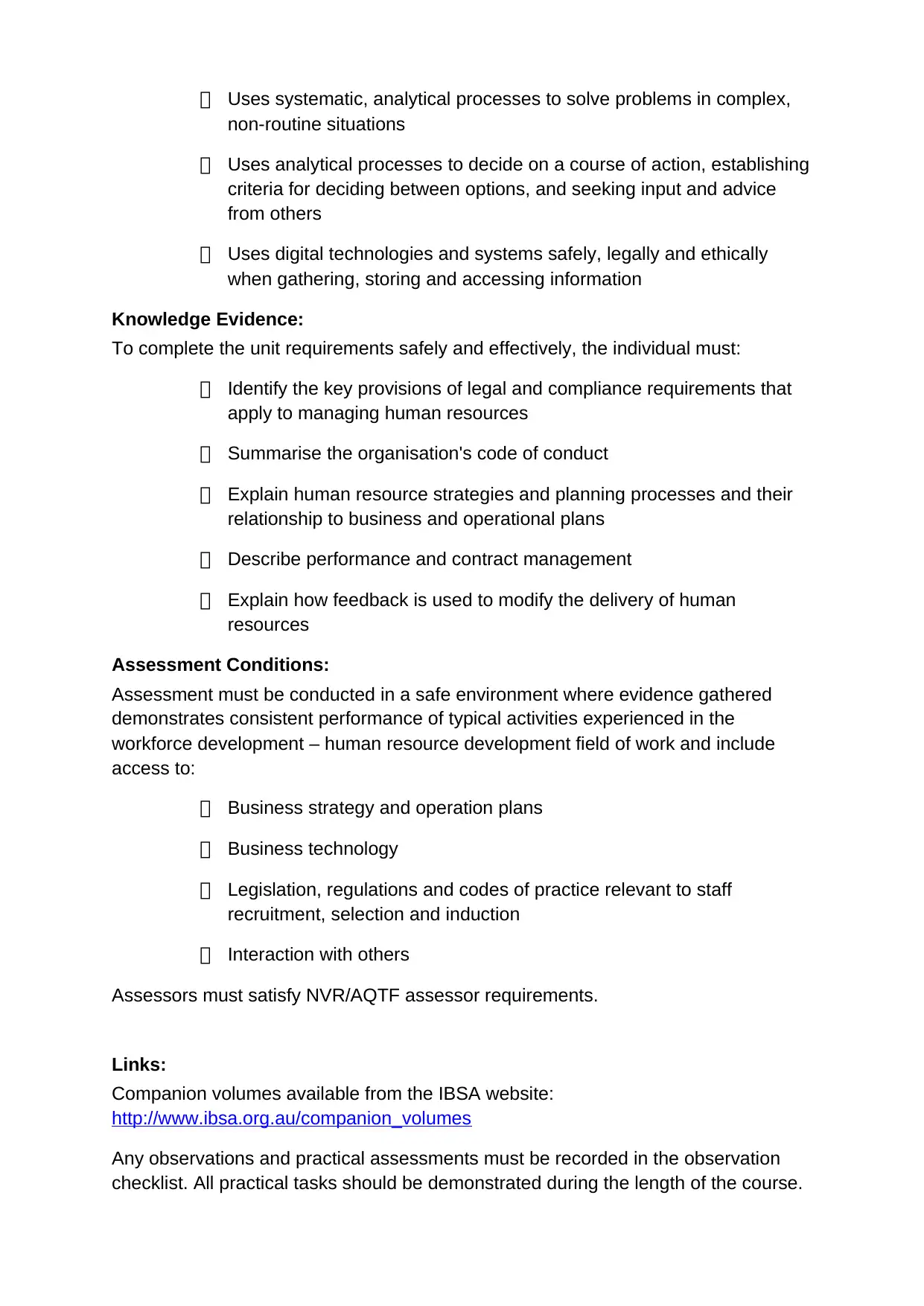
Uses systematic, analytical processes to solve problems in complex,
non-routine situations
Uses analytical processes to decide on a course of action, establishing
criteria for deciding between options, and seeking input and advice
from others
Uses digital technologies and systems safely, legally and ethically
when gathering, storing and accessing information
Knowledge Evidence:
To complete the unit requirements safely and effectively, the individual must:
Identify the key provisions of legal and compliance requirements that
apply to managing human resources
Summarise the organisation's code of conduct
Explain human resource strategies and planning processes and their
relationship to business and operational plans
Describe performance and contract management
Explain how feedback is used to modify the delivery of human
resources
Assessment Conditions:
Assessment must be conducted in a safe environment where evidence gathered
demonstrates consistent performance of typical activities experienced in the
workforce development – human resource development field of work and include
access to:
Business strategy and operation plans
Business technology
Legislation, regulations and codes of practice relevant to staff
recruitment, selection and induction
Interaction with others
Assessors must satisfy NVR/AQTF assessor requirements.
Links:
Companion volumes available from the IBSA website:
http://www.ibsa.org.au/companion_volumes
Any observations and practical assessments must be recorded in the observation
checklist. All practical tasks should be demonstrated during the length of the course.
non-routine situations
Uses analytical processes to decide on a course of action, establishing
criteria for deciding between options, and seeking input and advice
from others
Uses digital technologies and systems safely, legally and ethically
when gathering, storing and accessing information
Knowledge Evidence:
To complete the unit requirements safely and effectively, the individual must:
Identify the key provisions of legal and compliance requirements that
apply to managing human resources
Summarise the organisation's code of conduct
Explain human resource strategies and planning processes and their
relationship to business and operational plans
Describe performance and contract management
Explain how feedback is used to modify the delivery of human
resources
Assessment Conditions:
Assessment must be conducted in a safe environment where evidence gathered
demonstrates consistent performance of typical activities experienced in the
workforce development – human resource development field of work and include
access to:
Business strategy and operation plans
Business technology
Legislation, regulations and codes of practice relevant to staff
recruitment, selection and induction
Interaction with others
Assessors must satisfy NVR/AQTF assessor requirements.
Links:
Companion volumes available from the IBSA website:
http://www.ibsa.org.au/companion_volumes
Any observations and practical assessments must be recorded in the observation
checklist. All practical tasks should be demonstrated during the length of the course.
Paraphrase This Document
Need a fresh take? Get an instant paraphrase of this document with our AI Paraphraser
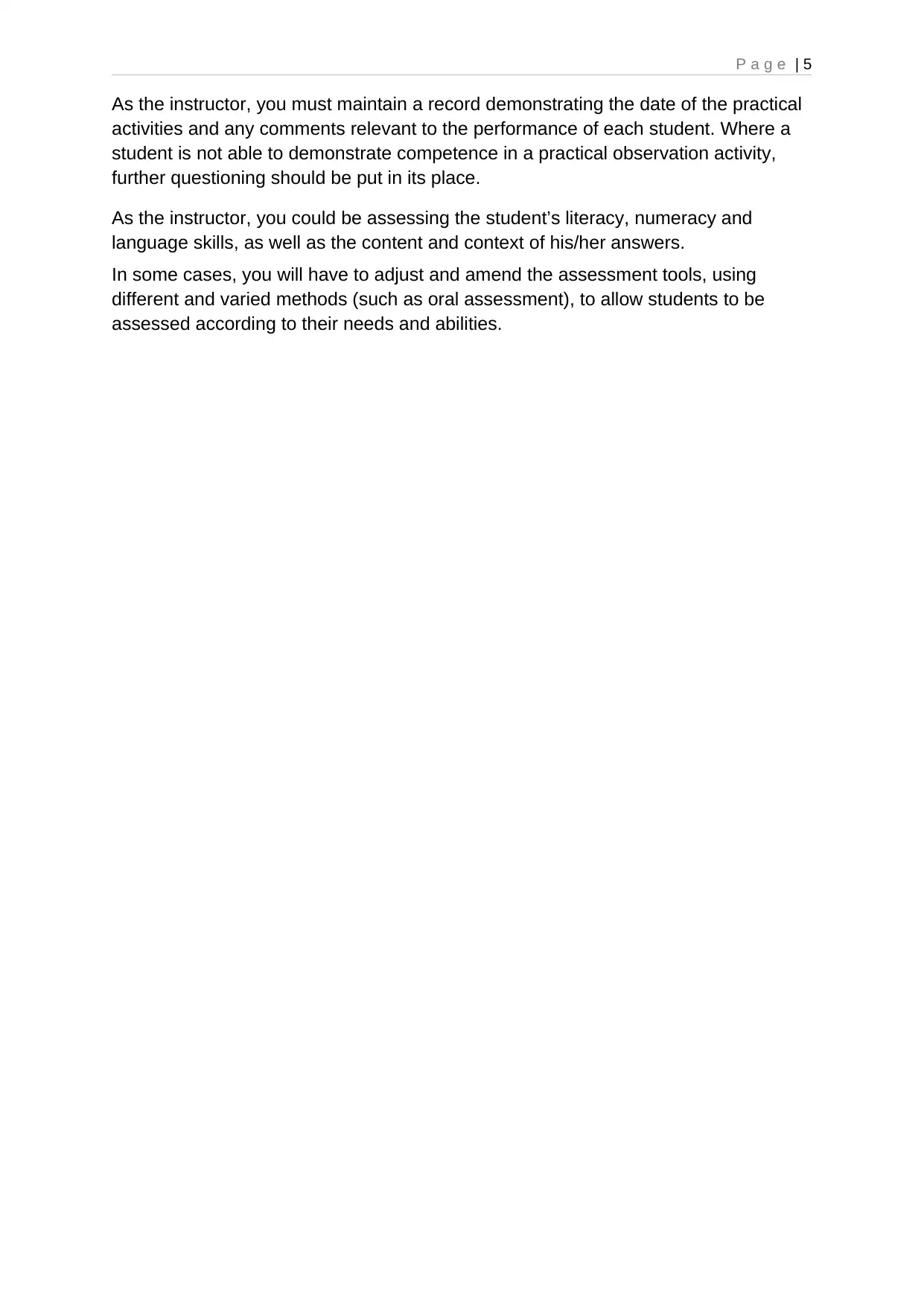
P a g e | 5
As the instructor, you must maintain a record demonstrating the date of the practical
activities and any comments relevant to the performance of each student. Where a
student is not able to demonstrate competence in a practical observation activity,
further questioning should be put in its place.
As the instructor, you could be assessing the student’s literacy, numeracy and
language skills, as well as the content and context of his/her answers.
In some cases, you will have to adjust and amend the assessment tools, using
different and varied methods (such as oral assessment), to allow students to be
assessed according to their needs and abilities.
As the instructor, you must maintain a record demonstrating the date of the practical
activities and any comments relevant to the performance of each student. Where a
student is not able to demonstrate competence in a practical observation activity,
further questioning should be put in its place.
As the instructor, you could be assessing the student’s literacy, numeracy and
language skills, as well as the content and context of his/her answers.
In some cases, you will have to adjust and amend the assessment tools, using
different and varied methods (such as oral assessment), to allow students to be
assessed according to their needs and abilities.
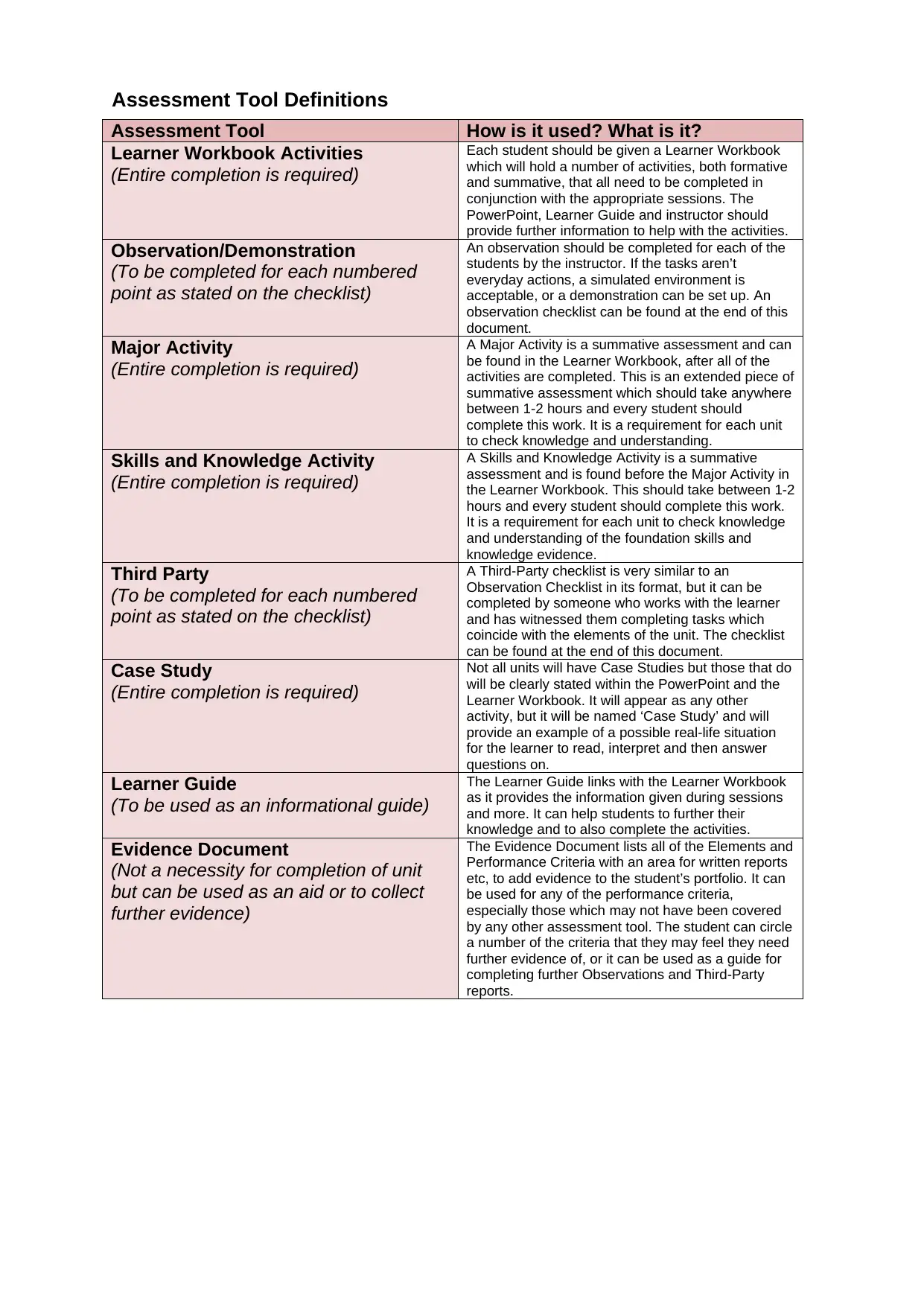
Assessment Tool Definitions
Assessment Tool How is it used? What is it?
Learner Workbook Activities
(Entire completion is required)
Each student should be given a Learner Workbook
which will hold a number of activities, both formative
and summative, that all need to be completed in
conjunction with the appropriate sessions. The
PowerPoint, Learner Guide and instructor should
provide further information to help with the activities.
Observation/Demonstration
(To be completed for each numbered
point as stated on the checklist)
An observation should be completed for each of the
students by the instructor. If the tasks aren’t
everyday actions, a simulated environment is
acceptable, or a demonstration can be set up. An
observation checklist can be found at the end of this
document.
Major Activity
(Entire completion is required)
A Major Activity is a summative assessment and can
be found in the Learner Workbook, after all of the
activities are completed. This is an extended piece of
summative assessment which should take anywhere
between 1-2 hours and every student should
complete this work. It is a requirement for each unit
to check knowledge and understanding.
Skills and Knowledge Activity
(Entire completion is required)
A Skills and Knowledge Activity is a summative
assessment and is found before the Major Activity in
the Learner Workbook. This should take between 1-2
hours and every student should complete this work.
It is a requirement for each unit to check knowledge
and understanding of the foundation skills and
knowledge evidence.
Third Party
(To be completed for each numbered
point as stated on the checklist)
A Third-Party checklist is very similar to an
Observation Checklist in its format, but it can be
completed by someone who works with the learner
and has witnessed them completing tasks which
coincide with the elements of the unit. The checklist
can be found at the end of this document.
Case Study
(Entire completion is required)
Not all units will have Case Studies but those that do
will be clearly stated within the PowerPoint and the
Learner Workbook. It will appear as any other
activity, but it will be named ‘Case Study’ and will
provide an example of a possible real-life situation
for the learner to read, interpret and then answer
questions on.
Learner Guide
(To be used as an informational guide)
The Learner Guide links with the Learner Workbook
as it provides the information given during sessions
and more. It can help students to further their
knowledge and to also complete the activities.
Evidence Document
(Not a necessity for completion of unit
but can be used as an aid or to collect
further evidence)
The Evidence Document lists all of the Elements and
Performance Criteria with an area for written reports
etc, to add evidence to the student’s portfolio. It can
be used for any of the performance criteria,
especially those which may not have been covered
by any other assessment tool. The student can circle
a number of the criteria that they may feel they need
further evidence of, or it can be used as a guide for
completing further Observations and Third-Party
reports.
Assessment Tool How is it used? What is it?
Learner Workbook Activities
(Entire completion is required)
Each student should be given a Learner Workbook
which will hold a number of activities, both formative
and summative, that all need to be completed in
conjunction with the appropriate sessions. The
PowerPoint, Learner Guide and instructor should
provide further information to help with the activities.
Observation/Demonstration
(To be completed for each numbered
point as stated on the checklist)
An observation should be completed for each of the
students by the instructor. If the tasks aren’t
everyday actions, a simulated environment is
acceptable, or a demonstration can be set up. An
observation checklist can be found at the end of this
document.
Major Activity
(Entire completion is required)
A Major Activity is a summative assessment and can
be found in the Learner Workbook, after all of the
activities are completed. This is an extended piece of
summative assessment which should take anywhere
between 1-2 hours and every student should
complete this work. It is a requirement for each unit
to check knowledge and understanding.
Skills and Knowledge Activity
(Entire completion is required)
A Skills and Knowledge Activity is a summative
assessment and is found before the Major Activity in
the Learner Workbook. This should take between 1-2
hours and every student should complete this work.
It is a requirement for each unit to check knowledge
and understanding of the foundation skills and
knowledge evidence.
Third Party
(To be completed for each numbered
point as stated on the checklist)
A Third-Party checklist is very similar to an
Observation Checklist in its format, but it can be
completed by someone who works with the learner
and has witnessed them completing tasks which
coincide with the elements of the unit. The checklist
can be found at the end of this document.
Case Study
(Entire completion is required)
Not all units will have Case Studies but those that do
will be clearly stated within the PowerPoint and the
Learner Workbook. It will appear as any other
activity, but it will be named ‘Case Study’ and will
provide an example of a possible real-life situation
for the learner to read, interpret and then answer
questions on.
Learner Guide
(To be used as an informational guide)
The Learner Guide links with the Learner Workbook
as it provides the information given during sessions
and more. It can help students to further their
knowledge and to also complete the activities.
Evidence Document
(Not a necessity for completion of unit
but can be used as an aid or to collect
further evidence)
The Evidence Document lists all of the Elements and
Performance Criteria with an area for written reports
etc, to add evidence to the student’s portfolio. It can
be used for any of the performance criteria,
especially those which may not have been covered
by any other assessment tool. The student can circle
a number of the criteria that they may feel they need
further evidence of, or it can be used as a guide for
completing further Observations and Third-Party
reports.
⊘ This is a preview!⊘
Do you want full access?
Subscribe today to unlock all pages.

Trusted by 1+ million students worldwide
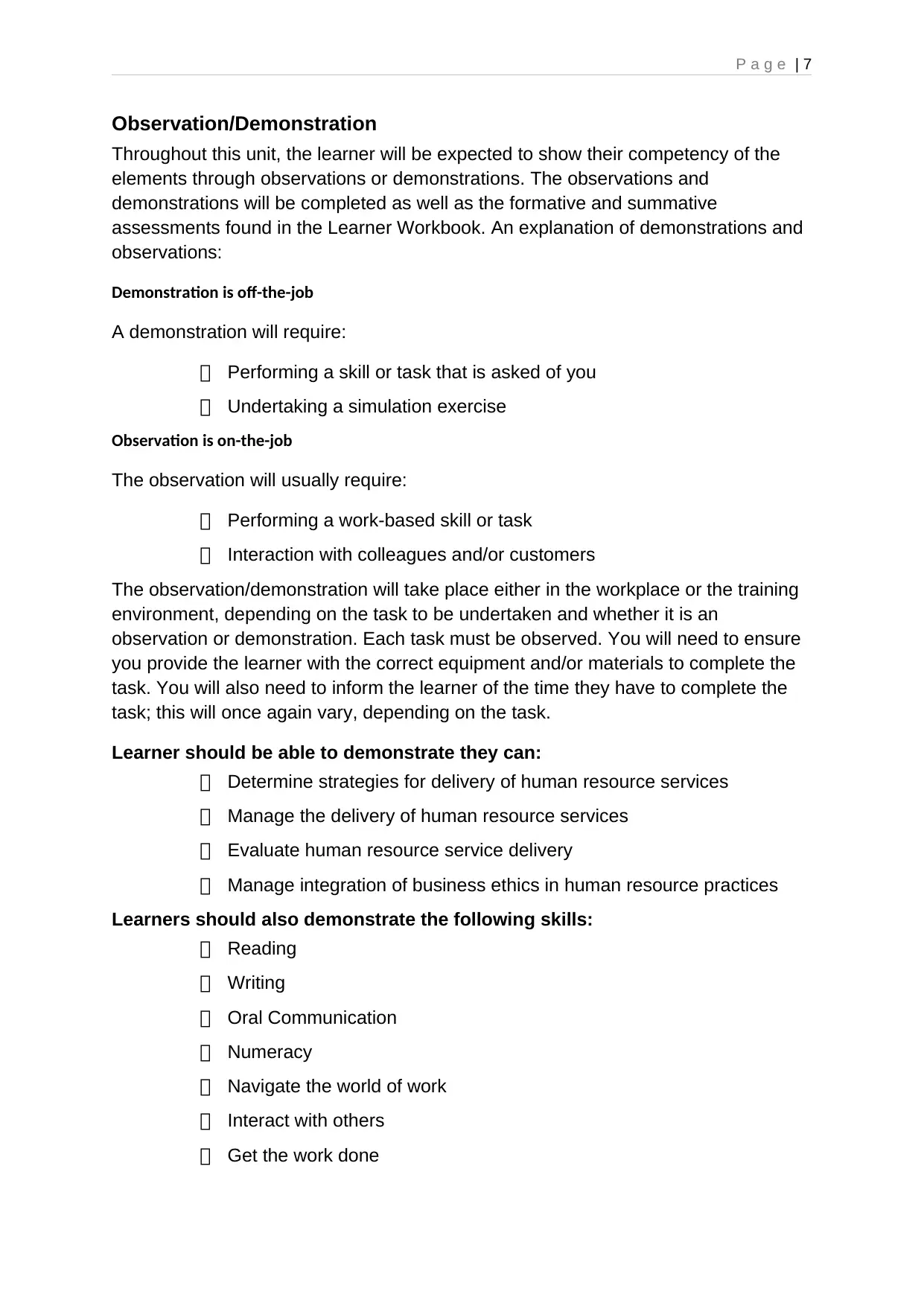
P a g e | 7
Observation/Demonstration
Throughout this unit, the learner will be expected to show their competency of the
elements through observations or demonstrations. The observations and
demonstrations will be completed as well as the formative and summative
assessments found in the Learner Workbook. An explanation of demonstrations and
observations:
Demonstration is off-the-job
A demonstration will require:
Performing a skill or task that is asked of you
Undertaking a simulation exercise
Observation is on-the-job
The observation will usually require:
Performing a work-based skill or task
Interaction with colleagues and/or customers
The observation/demonstration will take place either in the workplace or the training
environment, depending on the task to be undertaken and whether it is an
observation or demonstration. Each task must be observed. You will need to ensure
you provide the learner with the correct equipment and/or materials to complete the
task. You will also need to inform the learner of the time they have to complete the
task; this will once again vary, depending on the task.
Learner should be able to demonstrate they can:
Determine strategies for delivery of human resource services
Manage the delivery of human resource services
Evaluate human resource service delivery
Manage integration of business ethics in human resource practices
Learners should also demonstrate the following skills:
Reading
Writing
Oral Communication
Numeracy
Navigate the world of work
Interact with others
Get the work done
Observation/Demonstration
Throughout this unit, the learner will be expected to show their competency of the
elements through observations or demonstrations. The observations and
demonstrations will be completed as well as the formative and summative
assessments found in the Learner Workbook. An explanation of demonstrations and
observations:
Demonstration is off-the-job
A demonstration will require:
Performing a skill or task that is asked of you
Undertaking a simulation exercise
Observation is on-the-job
The observation will usually require:
Performing a work-based skill or task
Interaction with colleagues and/or customers
The observation/demonstration will take place either in the workplace or the training
environment, depending on the task to be undertaken and whether it is an
observation or demonstration. Each task must be observed. You will need to ensure
you provide the learner with the correct equipment and/or materials to complete the
task. You will also need to inform the learner of the time they have to complete the
task; this will once again vary, depending on the task.
Learner should be able to demonstrate they can:
Determine strategies for delivery of human resource services
Manage the delivery of human resource services
Evaluate human resource service delivery
Manage integration of business ethics in human resource practices
Learners should also demonstrate the following skills:
Reading
Writing
Oral Communication
Numeracy
Navigate the world of work
Interact with others
Get the work done
Paraphrase This Document
Need a fresh take? Get an instant paraphrase of this document with our AI Paraphraser
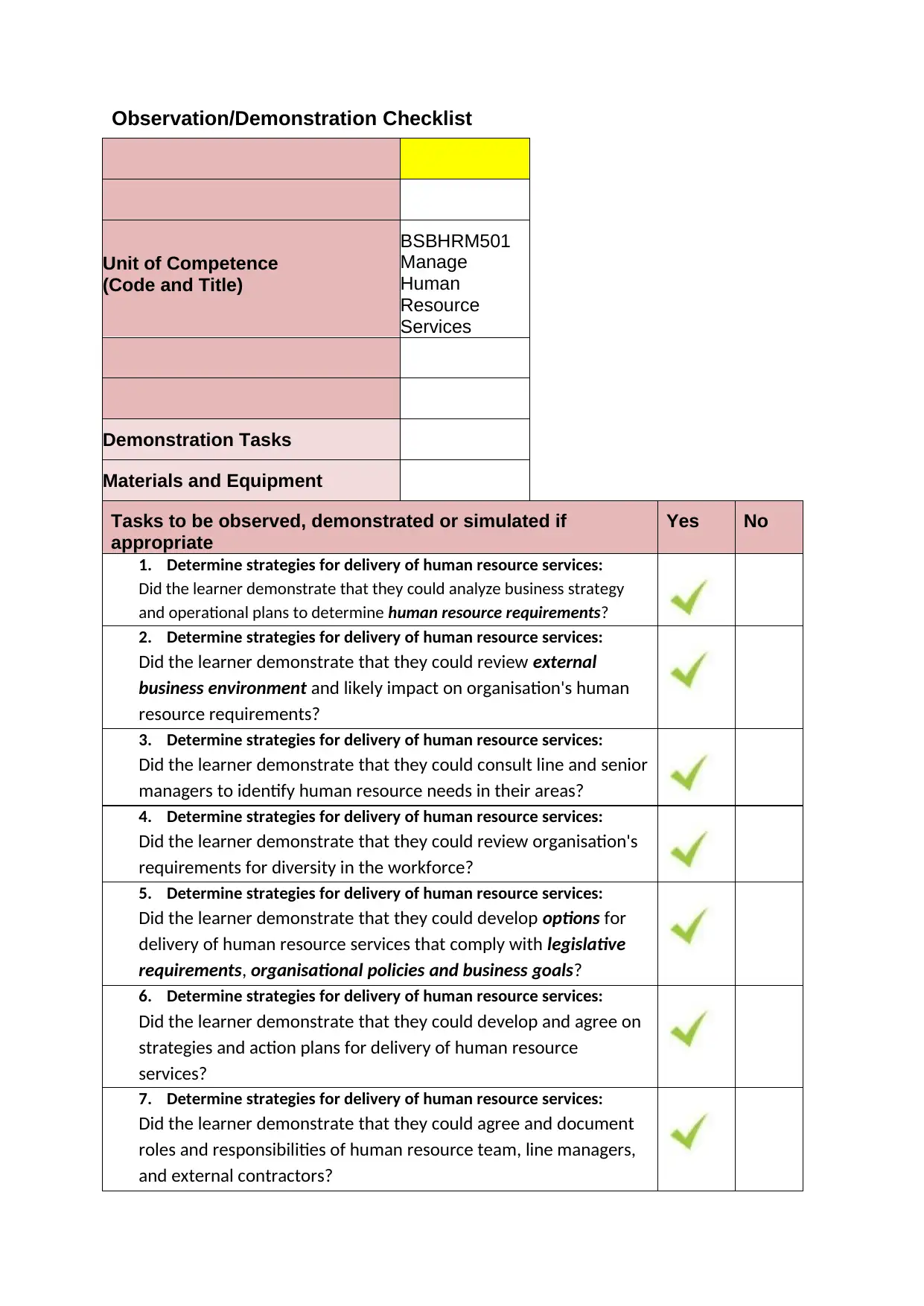
Observation/Demonstration Checklist
Unit of Competence
(Code and Title)
BSBHRM501
Manage
Human
Resource
Services
Demonstration Tasks
Materials and Equipment
Tasks to be observed, demonstrated or simulated if
appropriate
Yes No
1. Determine strategies for delivery of human resource services:
Did the learner demonstrate that they could analyze business strategy
and operational plans to determine human resource requirements?
2. Determine strategies for delivery of human resource services:
Did the learner demonstrate that they could review external
business environment and likely impact on organisation's human
resource requirements?
3. Determine strategies for delivery of human resource services:
Did the learner demonstrate that they could consult line and senior
managers to identify human resource needs in their areas?
4. Determine strategies for delivery of human resource services:
Did the learner demonstrate that they could review organisation's
requirements for diversity in the workforce?
5. Determine strategies for delivery of human resource services:
Did the learner demonstrate that they could develop options for
delivery of human resource services that comply with legislative
requirements, organisational policies and business goals?
6. Determine strategies for delivery of human resource services:
Did the learner demonstrate that they could develop and agree on
strategies and action plans for delivery of human resource
services?
7. Determine strategies for delivery of human resource services:
Did the learner demonstrate that they could agree and document
roles and responsibilities of human resource team, line managers,
and external contractors?
Unit of Competence
(Code and Title)
BSBHRM501
Manage
Human
Resource
Services
Demonstration Tasks
Materials and Equipment
Tasks to be observed, demonstrated or simulated if
appropriate
Yes No
1. Determine strategies for delivery of human resource services:
Did the learner demonstrate that they could analyze business strategy
and operational plans to determine human resource requirements?
2. Determine strategies for delivery of human resource services:
Did the learner demonstrate that they could review external
business environment and likely impact on organisation's human
resource requirements?
3. Determine strategies for delivery of human resource services:
Did the learner demonstrate that they could consult line and senior
managers to identify human resource needs in their areas?
4. Determine strategies for delivery of human resource services:
Did the learner demonstrate that they could review organisation's
requirements for diversity in the workforce?
5. Determine strategies for delivery of human resource services:
Did the learner demonstrate that they could develop options for
delivery of human resource services that comply with legislative
requirements, organisational policies and business goals?
6. Determine strategies for delivery of human resource services:
Did the learner demonstrate that they could develop and agree on
strategies and action plans for delivery of human resource
services?
7. Determine strategies for delivery of human resource services:
Did the learner demonstrate that they could agree and document
roles and responsibilities of human resource team, line managers,
and external contractors?
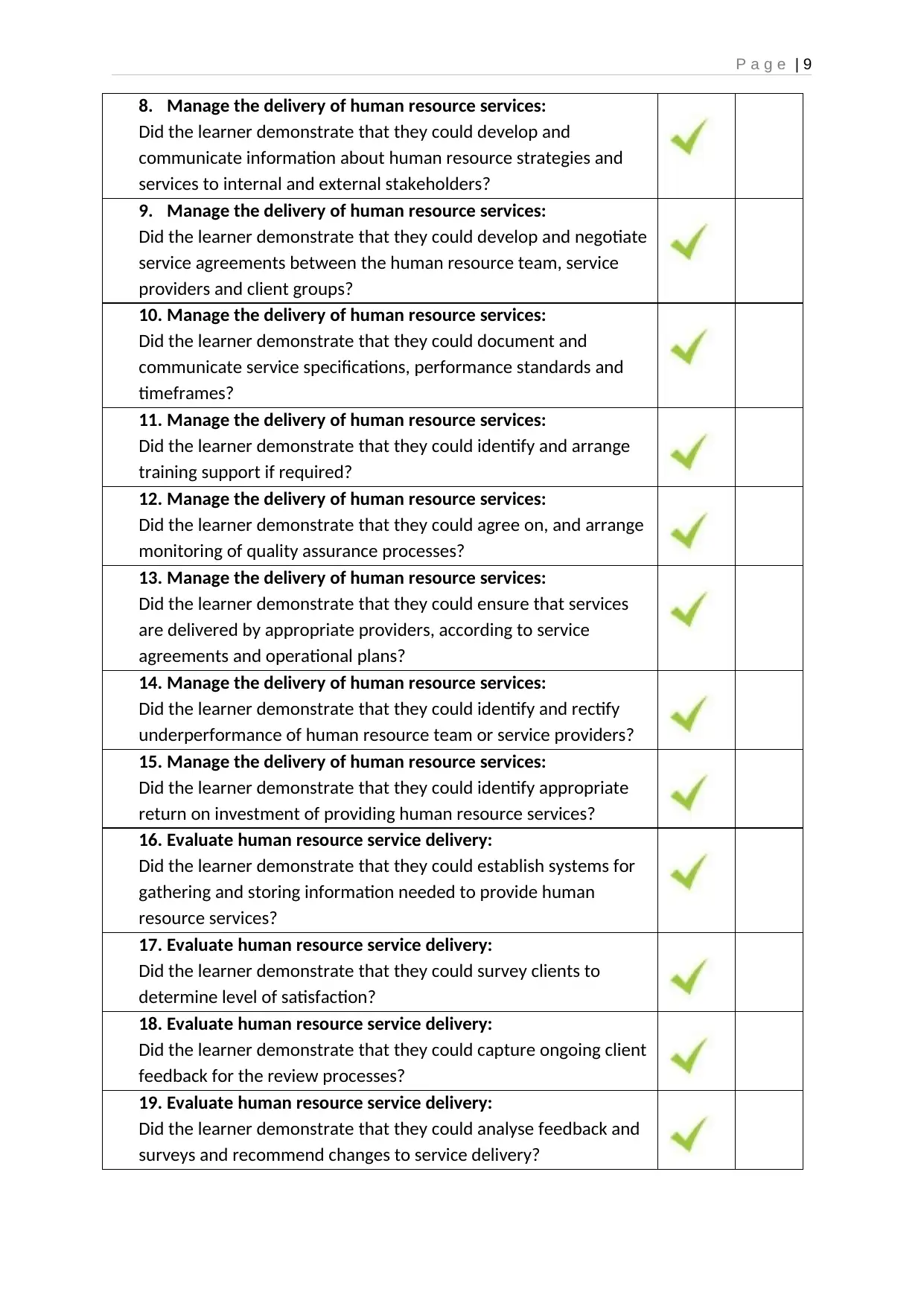
P a g e | 9
8. Manage the delivery of human resource services:
Did the learner demonstrate that they could develop and
communicate information about human resource strategies and
services to internal and external stakeholders?
9. Manage the delivery of human resource services:
Did the learner demonstrate that they could develop and negotiate
service agreements between the human resource team, service
providers and client groups?
10. Manage the delivery of human resource services:
Did the learner demonstrate that they could document and
communicate service specifications, performance standards and
timeframes?
11. Manage the delivery of human resource services:
Did the learner demonstrate that they could identify and arrange
training support if required?
12. Manage the delivery of human resource services:
Did the learner demonstrate that they could agree on, and arrange
monitoring of quality assurance processes?
13. Manage the delivery of human resource services:
Did the learner demonstrate that they could ensure that services
are delivered by appropriate providers, according to service
agreements and operational plans?
14. Manage the delivery of human resource services:
Did the learner demonstrate that they could identify and rectify
underperformance of human resource team or service providers?
15. Manage the delivery of human resource services:
Did the learner demonstrate that they could identify appropriate
return on investment of providing human resource services?
16. Evaluate human resource service delivery:
Did the learner demonstrate that they could establish systems for
gathering and storing information needed to provide human
resource services?
17. Evaluate human resource service delivery:
Did the learner demonstrate that they could survey clients to
determine level of satisfaction?
18. Evaluate human resource service delivery:
Did the learner demonstrate that they could capture ongoing client
feedback for the review processes?
19. Evaluate human resource service delivery:
Did the learner demonstrate that they could analyse feedback and
surveys and recommend changes to service delivery?
8. Manage the delivery of human resource services:
Did the learner demonstrate that they could develop and
communicate information about human resource strategies and
services to internal and external stakeholders?
9. Manage the delivery of human resource services:
Did the learner demonstrate that they could develop and negotiate
service agreements between the human resource team, service
providers and client groups?
10. Manage the delivery of human resource services:
Did the learner demonstrate that they could document and
communicate service specifications, performance standards and
timeframes?
11. Manage the delivery of human resource services:
Did the learner demonstrate that they could identify and arrange
training support if required?
12. Manage the delivery of human resource services:
Did the learner demonstrate that they could agree on, and arrange
monitoring of quality assurance processes?
13. Manage the delivery of human resource services:
Did the learner demonstrate that they could ensure that services
are delivered by appropriate providers, according to service
agreements and operational plans?
14. Manage the delivery of human resource services:
Did the learner demonstrate that they could identify and rectify
underperformance of human resource team or service providers?
15. Manage the delivery of human resource services:
Did the learner demonstrate that they could identify appropriate
return on investment of providing human resource services?
16. Evaluate human resource service delivery:
Did the learner demonstrate that they could establish systems for
gathering and storing information needed to provide human
resource services?
17. Evaluate human resource service delivery:
Did the learner demonstrate that they could survey clients to
determine level of satisfaction?
18. Evaluate human resource service delivery:
Did the learner demonstrate that they could capture ongoing client
feedback for the review processes?
19. Evaluate human resource service delivery:
Did the learner demonstrate that they could analyse feedback and
surveys and recommend changes to service delivery?
⊘ This is a preview!⊘
Do you want full access?
Subscribe today to unlock all pages.

Trusted by 1+ million students worldwide
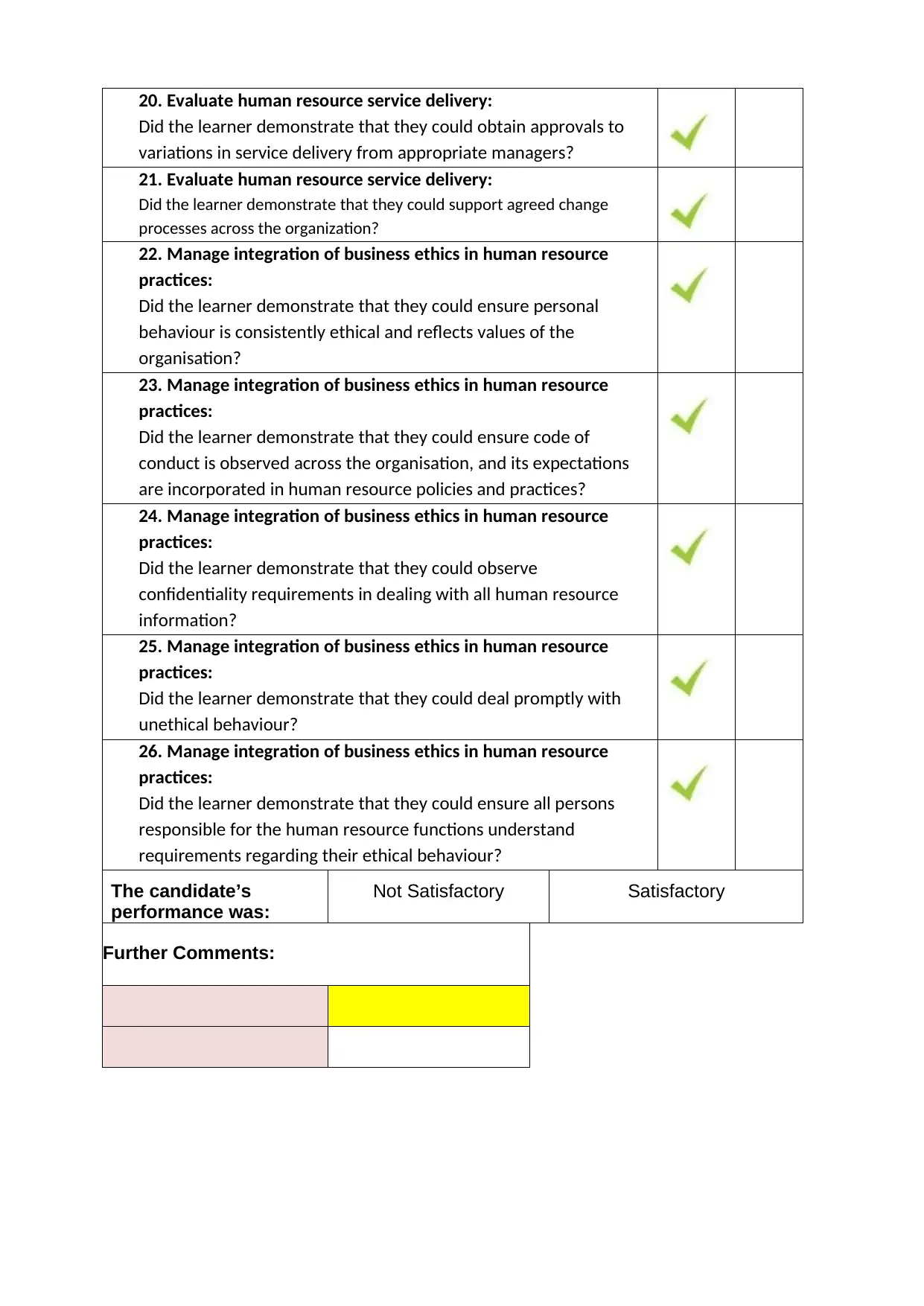
20. Evaluate human resource service delivery:
Did the learner demonstrate that they could obtain approvals to
variations in service delivery from appropriate managers?
21. Evaluate human resource service delivery:
Did the learner demonstrate that they could support agreed change
processes across the organization?
22. Manage integration of business ethics in human resource
practices:
Did the learner demonstrate that they could ensure personal
behaviour is consistently ethical and reflects values of the
organisation?
23. Manage integration of business ethics in human resource
practices:
Did the learner demonstrate that they could ensure code of
conduct is observed across the organisation, and its expectations
are incorporated in human resource policies and practices?
24. Manage integration of business ethics in human resource
practices:
Did the learner demonstrate that they could observe
confidentiality requirements in dealing with all human resource
information?
25. Manage integration of business ethics in human resource
practices:
Did the learner demonstrate that they could deal promptly with
unethical behaviour?
26. Manage integration of business ethics in human resource
practices:
Did the learner demonstrate that they could ensure all persons
responsible for the human resource functions understand
requirements regarding their ethical behaviour?
The candidate’s
performance was:
Not Satisfactory Satisfactory
Further Comments:
Did the learner demonstrate that they could obtain approvals to
variations in service delivery from appropriate managers?
21. Evaluate human resource service delivery:
Did the learner demonstrate that they could support agreed change
processes across the organization?
22. Manage integration of business ethics in human resource
practices:
Did the learner demonstrate that they could ensure personal
behaviour is consistently ethical and reflects values of the
organisation?
23. Manage integration of business ethics in human resource
practices:
Did the learner demonstrate that they could ensure code of
conduct is observed across the organisation, and its expectations
are incorporated in human resource policies and practices?
24. Manage integration of business ethics in human resource
practices:
Did the learner demonstrate that they could observe
confidentiality requirements in dealing with all human resource
information?
25. Manage integration of business ethics in human resource
practices:
Did the learner demonstrate that they could deal promptly with
unethical behaviour?
26. Manage integration of business ethics in human resource
practices:
Did the learner demonstrate that they could ensure all persons
responsible for the human resource functions understand
requirements regarding their ethical behaviour?
The candidate’s
performance was:
Not Satisfactory Satisfactory
Further Comments:
Paraphrase This Document
Need a fresh take? Get an instant paraphrase of this document with our AI Paraphraser
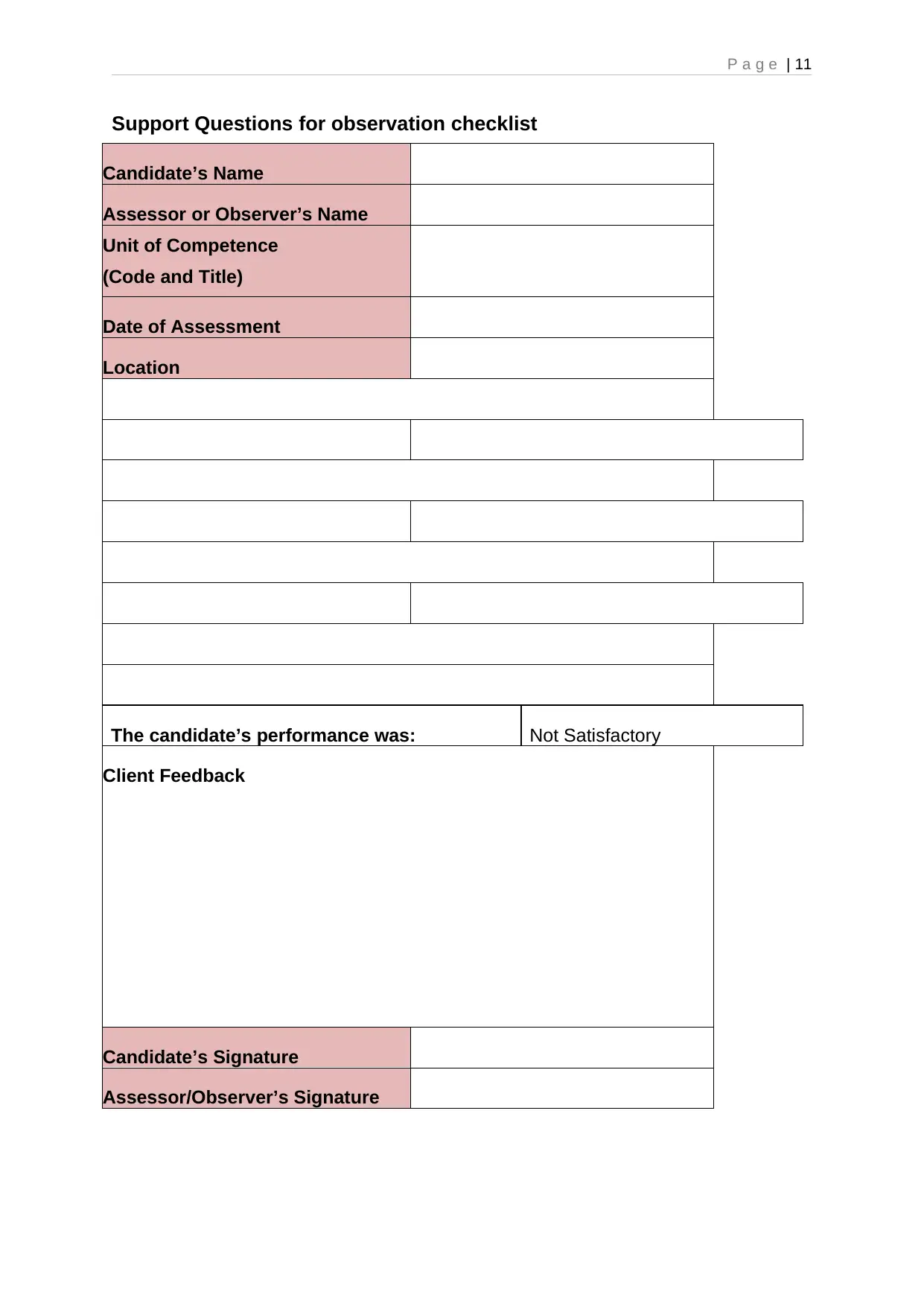
P a g e | 11
Support Questions for observation checklist
Candidate’s Name
Assessor or Observer’s Name
Unit of Competence
(Code and Title)
Date of Assessment
Location
The candidate’s performance was: Not Satisfactory
Client Feedback
Candidate’s Signature
Assessor/Observer’s Signature
Support Questions for observation checklist
Candidate’s Name
Assessor or Observer’s Name
Unit of Competence
(Code and Title)
Date of Assessment
Location
The candidate’s performance was: Not Satisfactory
Client Feedback
Candidate’s Signature
Assessor/Observer’s Signature
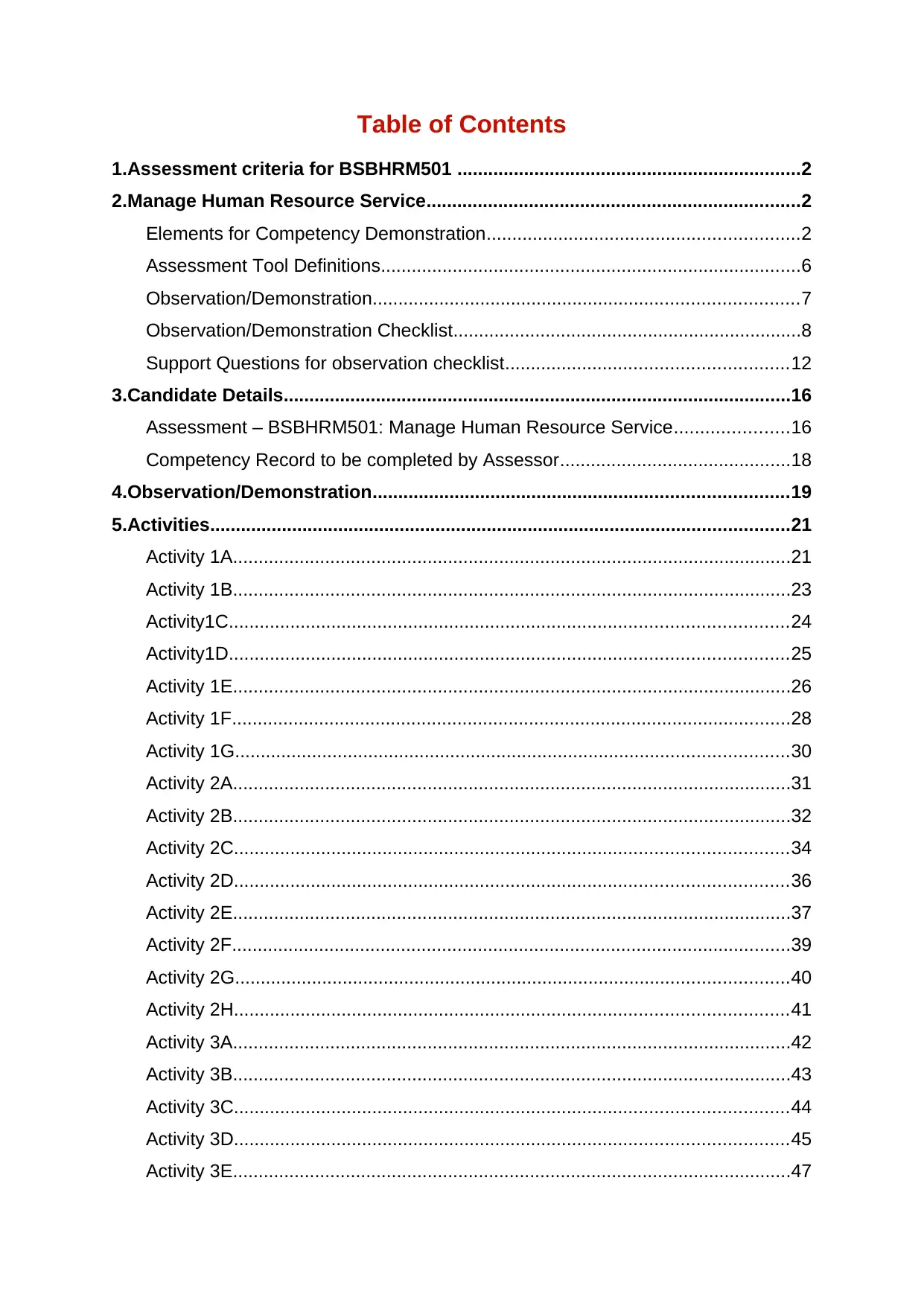
Table of Contents
1.Assessment criteria for BSBHRM501 ...................................................................2
2.Manage Human Resource Service.........................................................................2
Elements for Competency Demonstration.............................................................2
Assessment Tool Definitions..................................................................................6
Observation/Demonstration...................................................................................7
Observation/Demonstration Checklist....................................................................8
Support Questions for observation checklist.......................................................12
3.Candidate Details...................................................................................................16
Assessment – BSBHRM501: Manage Human Resource Service......................16
Competency Record to be completed by Assessor.............................................18
4.Observation/Demonstration.................................................................................19
5.Activities.................................................................................................................21
Activity 1A.............................................................................................................21
Activity 1B.............................................................................................................23
Activity1C.............................................................................................................24
Activity1D.............................................................................................................25
Activity 1E.............................................................................................................26
Activity 1F.............................................................................................................28
Activity 1G............................................................................................................30
Activity 2A.............................................................................................................31
Activity 2B.............................................................................................................32
Activity 2C............................................................................................................34
Activity 2D............................................................................................................36
Activity 2E.............................................................................................................37
Activity 2F.............................................................................................................39
Activity 2G............................................................................................................40
Activity 2H............................................................................................................41
Activity 3A.............................................................................................................42
Activity 3B.............................................................................................................43
Activity 3C............................................................................................................44
Activity 3D............................................................................................................45
Activity 3E.............................................................................................................47
1.Assessment criteria for BSBHRM501 ...................................................................2
2.Manage Human Resource Service.........................................................................2
Elements for Competency Demonstration.............................................................2
Assessment Tool Definitions..................................................................................6
Observation/Demonstration...................................................................................7
Observation/Demonstration Checklist....................................................................8
Support Questions for observation checklist.......................................................12
3.Candidate Details...................................................................................................16
Assessment – BSBHRM501: Manage Human Resource Service......................16
Competency Record to be completed by Assessor.............................................18
4.Observation/Demonstration.................................................................................19
5.Activities.................................................................................................................21
Activity 1A.............................................................................................................21
Activity 1B.............................................................................................................23
Activity1C.............................................................................................................24
Activity1D.............................................................................................................25
Activity 1E.............................................................................................................26
Activity 1F.............................................................................................................28
Activity 1G............................................................................................................30
Activity 2A.............................................................................................................31
Activity 2B.............................................................................................................32
Activity 2C............................................................................................................34
Activity 2D............................................................................................................36
Activity 2E.............................................................................................................37
Activity 2F.............................................................................................................39
Activity 2G............................................................................................................40
Activity 2H............................................................................................................41
Activity 3A.............................................................................................................42
Activity 3B.............................................................................................................43
Activity 3C............................................................................................................44
Activity 3D............................................................................................................45
Activity 3E.............................................................................................................47
⊘ This is a preview!⊘
Do you want full access?
Subscribe today to unlock all pages.

Trusted by 1+ million students worldwide
1 out of 74
Related Documents
Your All-in-One AI-Powered Toolkit for Academic Success.
+13062052269
info@desklib.com
Available 24*7 on WhatsApp / Email
![[object Object]](/_next/static/media/star-bottom.7253800d.svg)
Unlock your academic potential
Copyright © 2020–2025 A2Z Services. All Rights Reserved. Developed and managed by ZUCOL.




